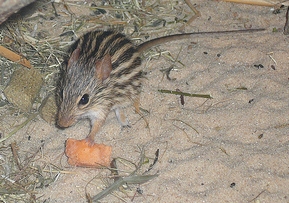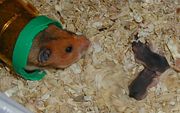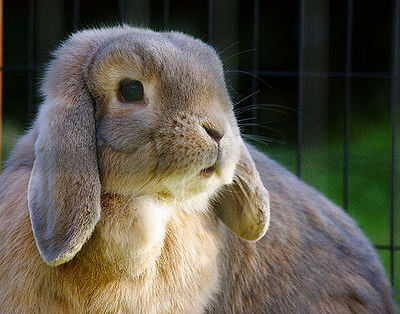Contents |
Appearance and personality
These little creatures are collequially known as micro squirrels and sometimes as the African Dwarf Dormouse, or Woodland Dormouse. Body length is about 9cm with a bushy tail at approximately 7cm. An average weight would be 18-30 grams – although you will not be able to weigh them!
Life span is about 5-6 years. Their main activity times are at dusk and dawn and they will be most active at night. African Pygmy Dormice are colony animals and need company, they should ideally be kept in same-sex groups of three or more to prevent them becoming unhappy and stressed.
These rodents are amazing to watch, they are incredibly agile and active – although at their best most likely when you are asleep. They are not at all suitable for a casual pet, or to give for a child as they are far too fast and shy. They are difficult also to breed, with fights between males being particularly vicious. Please think very carefully and do your research before getting these as pets.
Cage and Habitat
Because of their size these rodents can escape from very small areas, so normal barred cages are not suitable. Since these are climbing animals, the height of their habitat is far more important than the width. Since they need to be kept at a warm temperature an arboreal vivarium is a good choice, since this provides both the climbing area that is vital and helps retain heat. You must give your rodent adequete heat and bedding, otherwise they may go into a state of torpor.
As a temporary measure, you could also try an aquarium with a fitted mesh top. Shredded paper or aspen wood shavings are good beddings, you can also use material such as Megazorb.
In the wild they spend a good amount of time in trees, so branches can be placed in the aquarium along with ropes attached to the cage top for climbing. You must heat any branches you use in the oven at a high temperature for approximately 20 minutes prior to placing in the cage to cleanse. Please also check what type of wood you are using – not all are suitable, and some may be toxic.
Furnishing the habitat:
- Small, solid exercise wheel – never buy spoked wheels for any rodent, as they risk trapping feet or tails!
- Untreated wooden toys.
- Cardboard or plastic tubes – on the floor, or hung from branches or ropes.
- Wooden gardening trellis/ladders.
- Sisal Rope.
- Hammocks.
- Fake foilage/leaves – if your Dormice end up chewing these, then these should be removed. Otherwise, they provide good cover to help them feel secure.
- Rope toys – such as those available for parrots, although check the material carefully.
- Nesting boxes – You must provide as many nesting boxes for them as you have animals to prevent fighting. Nestboxes should ideally have more than one entrance/exit point and these should be quite small – the round nestboxes designed for bluetits are ideal.
Feeding
Your dormouse has complicated food requirements – they cannot simply be fed on the same diet as your hamster, as this is tantamount to neglect. They should be offered a selection of the following:
- Water: although they should get plenty from their fruit, water should always be available. You can use a small ceramic dish and some breeders report that dormice are happy using bottles.
- Fruit: should be supplied most days. Citrus fruits are not approved of, but things such as the following are: seedless grapes, apples, papaya, melon, tomato, banana, and blueberries.
- Protein: again this should be constantly available, especially if you have a breeding pair or colony. Cheese, boiled or scrambled eggs, small amounts of boiled chicken, salmon, tuna (in spring water preferred), crayfish or prawns.
- Insect Food: usually offered for garden birds, this should be constantly available.
- Egg Food: particularly important for the girls if you are breeding, this can be available constantly.
- Maple Syrup: this is vital and very loved – see http://www.geocities.com/pygmydormouse/main.htm for details.
- Treats: such as mealworms, monkey nuts, sunflower seeds, and pumpkin seeds are always popular. You can also buy live crickets which are sure to go down well.
Handling
These animals are very difficult to handle and may never become tame to you – they are very much a pet to observe and not to touch. If they have been handled from a young age and are from a reputable breeder, it is possible they may tolerate interaction with you. Bonding pouches such as those used for Sugar Gliders can be successful if used at a young age, however always bear in mind that these are extremely quick, agile and nervous rodents who are very sensitive to light.
If you find your dormouse is shivering and its body is very cold to touch, it may be in a state of torpor. If these is the case you can warm them gently up in your hands, although be careful to return them to their cage once they warm up. Torpor can be caused by the heat, or through fear – check that your house is at a comfortable temperature between 21 – 27 oC and that you are feeding them a good and varied diet as stated above.
Video
External Websites
- Crittery’s guide to the African Pygmy Dormouse: http://www.crittery.co.uk/apd/dormice.php
- Mark Bonds guide to the APD: http://www.geocities.com/pygmydormouse/main.htm
- Woodland Dormouse Wikipedia: http://en.wikipedia.org/wiki/Woodland_Dormouse



